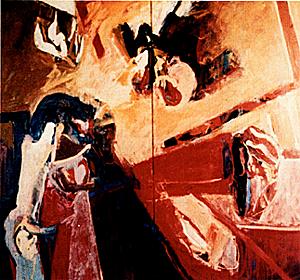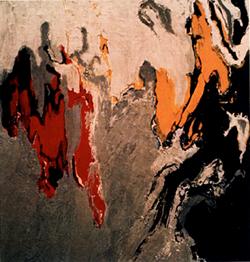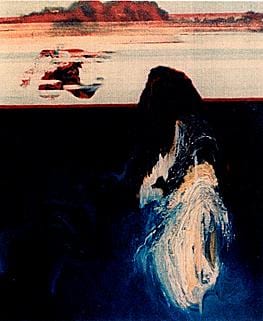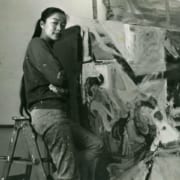Interview with Bernice Bing
INTERVIEW WITH ARTIST
Selections from interviews with Bernice Bing by Moira Roth and Diane Tani, August 13 and 24, 1991.
In 1961, Bernice Bing graduates from the San Francisco Art Institute in its first Masters program; among her fellow students are Joan Brown, Robert Hudson, Leo Valledor, Alvin Light, Cornelia Schulz and William T. Wiley. Also during this year, she is given her first one-person exhibition at the Batman Gallery in San Francisco.
I painted Diptych [Plate 1], a twelve by eight feet double panel, as my main project in the Masters program. It was part of a whole series of work I showed in the Batman Gallery. Unfortunately the painting got ruined in Mayacamas because I stored it there in the barn; it got very badly mildewed, so that it does not exist any more–I only have a slide.
Some of the paintings of this time are very figurative, very visceral. I deal with angles and play with perspective and light–light has always been an important aspect of my work. At that time I was also much involved in looking at a lot of Arshile Gorky’s work, and Gorky has this wonderful sense of space and juxtaposes very fluid organic shapes with some angular planes, so I was playing with that sort of juxtaposition, too.
How did people react to your 1961 exhibition at the Batman Gallery?
That show was a very impressive one, and people were somewhat surprised at my work because I hadn’t made a lot of noise at school. So, when I had that exhibition, people were rather taken aback by it. I liked that; I like surprises!
The Batman Gallery was opened by a young man, financed by his father who was in the garment business in Chicago, and who had given his son all this money to open a gallery. It was an unusual place–for instance the fact that its name was Batman, and that it was all totally black: black floor, black ceilings, the complete opposite of what you saw in most galleries with their stark white walls. All the artists I knew were pretty excited about the space. The first person who had a show there, and may have had something to do with the name and black walls, was Bruce Conner. My show was one of the first ten shows at the Batman Gallery.
Was it surprising to see your paintings against an all-black background?
Yes, especially these paintings. They had layers of thin transparencies, areas like washes, as I was overlaying highly spontaneous brush strokes on areas of color which were more opaque. I used techniques that Diebenkorn had employed in his earlier landscapes: washes over solid colors. There were also places in my paintings that had impasto brush strokes, and during that time in my palette, I used a lot of primary colors. The objects were heavily reds in a fusion of light and a sort of atmospheric void. The forms would be placed in this void. The way one identifies the distance between objects and the void was by how the angles and planes were set. The object forms were set right in the foreground, then there was a middle ground and then this infinite nothingness in the back–all manipulated by paint. I am stylizing some of these dynamics.
What I am doing now is using a combination of images from the early Sixties, with a combination of the organic planes and masses of the later Sixties. The Seventies were kind of experimental for me…but in my work of the Eighties, I came back in using the abstract, and using planes. But I also introduced something new–more fluent and dynamic calligraphic strokes and images–into the landscape form. For instance, in the 1990 Lotus Root [Plate 10] , the impasto of the paint, the masses, is built up through calligraphic lines.
In 1963, Bing leaves San Francisco to live for three years in the country. In this setting of the Mayacamas vineyards, and in a far more solitary ambiance than her earlier urban one, she first creates paintings that are inspired by nature.
Elements [Plate 2] was painted at the Mayacamas vineyards, but again I no longer have it because it was among a series of canvases that were stolen–I only have photographic records. After I left school, I needed to do something to support myself, and this job came up at the vineyards, and I thought, well I’ll just take a year off but instead of taking a year, I took three years. I was in my mid-twenties when I painted this and other paintings which are derivative of the landscape around the Mayacamas Mountain range on the western side of the Napa Valley.
It was the first time I had really lived in a rural environment and it was all pretty new and exciting to transpose from an urban living situation in San Francisco to this. I was profoundly touched by this new world–nature and the changes of the seasons that I had suddenly discovered. So I did a series of landscapes which were very organic. I wanted to concentrate not so much on images that would appear as landscape but rather to capture its ongoing changing dynamics of light. The impact of this on masses and shadows produces a pictorial mode which gives you a sense of the overpowering spirituality that one feels when one is in a natural environment. Leaving the city to live in the country was a very important point in my life. These Mayacamas canvases, unlike the earlier ones I did in San Francisco, are opaque and painted with impasto brush stroke. They have definite tactile surface because nature itself is so tactile.
For nine months in 1967, Bing attends the first residency program of the Esalen Institute in Big Sur. There she plunges into its program of New Age psychology and mysticism, as well as extending her interests in the writing of Carl Jung, the Swiss psychologist, theorist and mystic. She also creates a series of small works, including Big Sur.
While I was living in the Mayacamas vineyards, before I applied to the Esalen residency program, I had become very interested in Jung’s work. I was impressed with his autobiography, Dreams, Memories and Reflections and with his ideas about the collective unconscious, and his use of symbols. It was a time of change–the Sixties, the flower child movement…things were happening with “altered states,” and I was interested in finding out more about these “altered states,” which can happen in dreams and creative work. So I investigated Esalen and it just seemed like a new world there. They were developing a whole new concept of parapsychology, looking into altered states. They were starting a residency program and were searching for candidates, so I applied. I raised money on my own by selling and raffling off works (about two thousand dollars) and was accepted for the nine-month program.
At Esalen, it was quite intense and all very new. One of the benefits of the residency was having the freedom to go to all the workshops. It was a wonderful experience. There was just an overwhelming number of minds who were introducing a whole new way of educating, examining and approaching therapy by starting to work in groups and with group dynamics.
This was the period when I painted Big Sur [Plate 3]. Earlier on I had done some small works in watercolor and on cardboard but this particular painting is the only one I completed at Esalen. Everything is horizontal with the ocean and then there’s this vertical rock. Basically it was about the intensity of breaking through the rock to the core of the inner self. It has the intensity of the red sky with a mythical creature, a sort of demonic unconsciousness, breaking through. It’s a pretty intense painting.
During 1975-1977, Bernice Bing creates a series of thirteen works [Plate 4] in a range of media in response to the well-known Netherlandish 15th century painting, Portrait of a Lady by Rogier van der Weyden.
When I was back in Washington one time, I went to the National Gallery and was very impressed by a small painting by Rogier van der Weyden which is some twenty-one by eighteen inches. I was moved by its simplicity. I liked the posture and I said to myself, well, why couldn’t this be a universal posture? I kept the posture the same but changed the mood and emotional quality and the ethnicity of the woman, and took the image into fantasy and mythology. The series also encompassed technical changes. I went from working with lead pencil, then prisma colors and ink and gouache and finally to oil pastels. These shifts in material dictated different light qualities and mood changes in the series as it progressed.
The series starts with a European woman followed by a Middle Eastern, African, Asiatic and a veiled Middle Eastern woman. Then it goes into the mythology of the goddesses of the moon, and the sun, and the serpent to a final very abstract image.
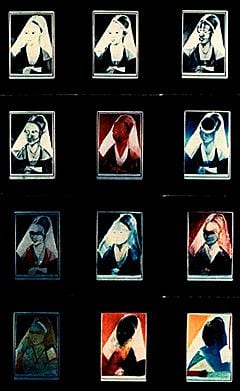
Plate 4, Series on Rogier van der Weyden, Portrait of a Lady, 1975-1977
Each portrait measures
17 1/2″ x 12 1/2″
Graphite
Private Collections
This SOMAR exhibition consists of work Bing has made since 1985, when she moved to Philo, a small town in Mendicino county. Here, she has created work that combines her earlier interests in Abstract Expressionism with the impact of her first visit to China in 1984. Bing’s most recent work is in response to reading about quantum theories in the New Physics.
After my return from China in 1985, I wanted seriously to get back into painting again because I felt that my life had been overtaken by being an arts administrator for the past five years. As Director of the South of Market Cultural Center, I had not been the artist I wanted to be. So, I moved to the country and that worked out well. I was able to set up a studio and really began to paint. I started out with works on paper using the calligraphic and brush stroke exercises I had learned during my short stay at the Zhejiang Academy in Haungzhou. I did warm-up exercises with calligraphy and calligraphic characters and finally I developed a way of doing very spontaneous images. In 1985, I did mostly works on paper, and after that I worked back into the oil medium. I started using these calligraphic studies with a combination of my natural environment in Philo as a means of departure for the new work. I began employing calligraphic lines to create areas of great density, of masses, and working with overlays of color to create the intensity of light, etc. in the landscape. Most of the mass images, of course, were inspired by my earlier interest in the Abstract Expressionist school of painting, which dealt with a great deal of mass, composition, planes; highly impasto qualities of paint on the canvas, and the emphasis on intuitive and emotional color.
In the development of calligraphy in pictographs to ideograms, there is a wonderful refined simplicity and yet complexity of the calligraphic language because it encompasses poetry, meaning and visual aesthetics. One can just look at a piece of calligraphy and not have to respond to its ideogram meaning but rather to its aesthetic meaning which becomes its poetry. This led me to think about how I had been approaching the canvas in a very traditional western way. You have a two-dimensional essence or you use color and form in some very symbolic way.
In my more recent work, I began very simply in black and white to make images that are elements of the whole. So this Quantum Series will be made up of ninety-nine individual black and white pattern panels to be installed on the wall of SOMAR, where each element will become part of the larger image: That is all I can say right now because the exciting part of it is that I have been working only on these individual pieces while keeping in mind the total outcome: Yet the total will not be known until the installation. So that is quite a different approach from how I used to deal with imagery when I would create an image on a single surface.
Somehow the concept of “quantum” for me has a lot to do with the new kind of thinking in my art. My most recent work responds to ideas about the quantum. It is only fairly recently that I have been reading about the New Physics: I was very inspired by The Tao of Physics by Fritjof Capra.
Quantum meaning…?
Quantum, as I understand it, is about the realms of possibilities. The scientists are now looking at the sub-atom community; the fact that a particle can be either an entity in itself or can become a wave. I also understand there is now a whole new concept in physics about theories of “Chaos.”
So your next series might be entitled Chaos…?
(Bing laughs.) Yes. What I am doing now is to see how the idea of the quantum will work in a visual sense and in an organic way. It is phenomenal that the installation turned out to have ninety-nine pieces.
Why that number?
It worked out that way. A hundred is an even number but for some reason when I worked up a mockup using address labels they came to ninety-nine labels, nine up and eleven across. That arrangement may change when I actually go to install the piece at the gallery. It is certainly not going to be in any way similar to the mockup which only gave me a sense of how it might be. Here we are again in the quantum realm of possibilities. So, all this is a totally different kind of thinking for me.
One-Person Exhibition
SOMAR Gallery
San Francisco
September 12 – October 12, 1991
Exhibition Catalog
Edited by Moira Roth & Diane Tani
Selections from interviews with Bernice Bing by Moira Roth and Diane Tani, August 13 and 24, 1991.

